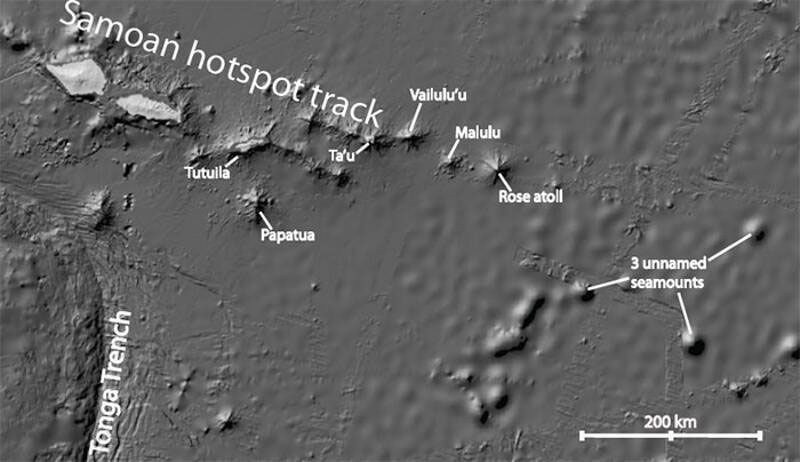What is a hotspot volcano?
In geology, a hotspot is an area of the Earth’s mantle from which hot plumes rise upward, forming volcanoes on the overlying crust.

Samoa is composed of a linear chain of volcanic islands situated atop the Pacific tectonic plate. Samoa is an example of one of at least 28 plume-fed volcanic hotspots are suggested to exist on the Earth’s surface. Figure made with assistance from Drew Reinhard. Download image (jpg, 54.5 KB).
In much the same way that plumes rise buoyantly in a lava lamp, plumes of mantle magma (molten rock) are theorized to rise buoyantly from a source within Earth’s deep mantle. When such a plume rises into the shallow mantle, it partially melts and the melt may then rise to the surface where it can erupt as a hotspot volcano. Hotspot volcanism is distinct in that it does not originate from processes that produce the more common submarine volcanism that occurs at boundaries of Earth’s tectonic plates.
Mantle plumes that form hotspots are thought to be relatively stationary whereas the overlying tectonic plates typically are not. Thus, as a plate moves over the location of a plume eruption, it carries successively older volcanoes with it. As hotspot volcanoes are transported by plate motion away from the mantle plume, hotspot volcanism ceases. Eventually the hotspot volcanoes become extinct, gradually subside, and are eroded by wave action. Over geologic time, these processes produce lines of islands, atolls, and seamounts known as hotspot tracks, or chains. The youngest, active volcanoes are located within a region of the plate that overlies the mantle plume. Progressively older volcanoes form linear chains on the surface of the moving tectonic plate, downstream of the hotspot. Earth scientists use the directions of these volcanic chains, along with the age progression of the chain’s volcanoes, to reconstruct histories of the relative motion between plates.
The Hawaiian Islands and the chain of seamounts that continue their trend for about 6,000 kilometers (3,750 miles) into the northwest Pacific Ocean are an example of a hotspot track. The Island of Hawai'i is the youngest, and most active, volcano in the chain. Active volcanism on Loihi Seamount, which is located off the southeast flank of the Island of Hawai'i, however, may signal the future location for creation of a new island in the Hawaiian chain.
While the hotspot volcanism theory successfully explains the linear relationship between age and distance within some long-lived volcanic chains (e.g., the Samoan and Hawaiian Islands), it does not give an explanation for the temporal and spatial pattern of volcanism within others (e.g., Cook-Australs, Marshalls, Gilberts, and Line Islands). This has led to scientific debate about whether hotspots are actually deep phenomena or even “fixed” in position, with some researchers abandoning the hotspot plume theory altogether. Such is the nature of science and why we continue to explore and learn.